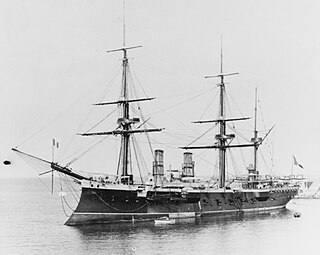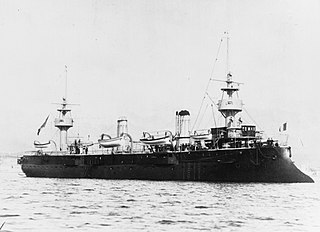
The Dévastation was an Dévastation-class ironclad battleship of the French Navy of central battery (casemate) design. She was used as a school ship for manoeuvres.

Courbet was an Dévastation-class ironclad central battery battleship of the French Navy.

Magenta was an ironclad barbette ship of the French Navy built in the 1880s and early 1890s. She was the third and final member of the Marceau class. The Marceau class was based on the earlier Amiral Baudin class of barbette ships, but with smaller guns: four 340 mm (13.4 in) weapons compared to the three 420 mm (16.5 in) guns of the earlier vessels. The ships introduced the lozenge arrangement for their main battery that became common for many French capital ships built in the 1890s. Magenta and her sister ships suffered from a number of problems, including poor stability, insufficient armor protection, and excessive displacement.

Marceau was an ironclad barbette ship built for the French Navy during the 1880s, the lead ship of her class. She served in the Mediterranean Squadron until 1900, when she was rebuilt and subsequently placed in reserve. She returned to service in 1906 as a torpedo training ship. During World War I, she served in Malta and Corfu as a submarine tender. The old ironclad was sold for scrapping in 1920, and while being towed to Toulon, she ran aground in a gale off Bizerte and became stranded. The wreck remained visible there until the 1930s.

Hoche was an ironclad battleship built as a hybrid barbette–turret ship for the French Navy in the 1880s. Originally designed in response to very large Italian ironclads along the lines of the French Amiral Baudin class, by the time work on Hoche began, changes in French design philosophy led to a radical re-design that provided the basis for a generation of French capital ships. Her armament was reduced in size compared to the Amiral Baudins, and was placed in the lozenge arrangement that would be used for most French capital ships into the 1890s. Hoche suffered from serious stability problems that resulted from her large superstructure and low freeboard, which required extensive work later in her career to correct. The ship incorporated new technologies for the French Navy, including gun turrets for some of her main battery guns and compound armor plate.

Amiral Duperré was an ironclad barbette ship built for the French Navy in the 1870s and 1880s; she was the first vessel of that type built by France. She carried her main battery of four 34 cm (13.4 in) guns individually in open barbette mountings, which offered increased fields of fire compared to earlier central battery ships, though they were less well protected. Amiral Duperré was ordered as part of a French naval construction program aimed at countering the growth of the Italian fleet, which had begun work on the very large ironclads of the Duilio and Italia classes in the early 1870s. The Italian vessels, armed with 45 cm (17.7 in) guns, prompted public outcry in France that pressured the navy to develop larger guns for its own ships. Amiral Duperré's design served as the basis for several follow-on classes, including the Bayard and Amiral Baudin classes.

Troude was a protected cruiser of the French Navy, the lead ship of the Troude class. The class was built as part of a construction program intended to provide scouts for the main battle fleet. They were based on the preceding Forbin class, the primary improvement being the addition of armor to the conning tower. Troude was built in the 1880s and was completed in late 1890. She was armed with a main battery of four 138 mm (5.4 in) guns, protected with an armor deck that was 41 mm (1.6 in) thick, and had a top speed of 20.5 knots.

Milan was a late-19th-century unprotected cruiser in the French Navy. At the time of her completion, Milan was considered by several publications to be the fastest warship in the world. The warship was the last unprotected cruiser in French naval service, and Milan's design influenced the construction of later protected cruisers.

The Jean Bart class comprised two protected cruisers of the French Navy built in the late 1880s and early 1890s; the two ships were Jean Bart and Isly. They were ordered as part of a fleet program that accorded with the theories of the Jeune École, which proposed a fleet based on cruisers and torpedo boats to defend France. The Jean Bart-class cruisers were intended to serve a long-range commerce raiders to attack enemy merchant shipping. The ships were armed with a main battery of four 164 mm (6.5 in) guns supported by six 138 mm (5.4 in) guns and they had a top speed of 19 to 19.5 knots.

Vauban was the lead ship of the Vauban class of ironclad barbette ships built for the French Navy in the late 1870s and 1880s. Intended for service in the French colonial empire, she was designed as a "station ironclad", smaller versions of the first-rate vessels built for the main fleet. The Vauban class was a scaled down variant of Amiral Duperré. They carried their main battery of four 240 mm (9.4 in) guns in open barbettes, two forward side-by-side and the other two aft on the nautical. Vauban was laid down in 1879 and was completed in 1885.

Duguesclin was an ironclad barbette ship built for the French Navy in the late 1870s and 1880s; she was the second and final member of the Vauban class. Intended for service in the French colonial empire, she was designed as a "station ironclad", which were smaller versions of the first-rate vessels built for the main fleet. The Vauban class was a scaled down variant of Amiral Duperré. They carried their main battery of four 240 mm (9.4 in) guns in open barbettes, two forward side-by-side and the other two aft on the centerline. Duguesclin was laid down in 1879 and was completed in 1885. Despite the intention to use her overseas, the ship remained in home waters for the duration of her career, serving with the Mediterranean Squadron from 1888 to 1895, though the last two years were as part of the Reserve Division. She spent the next several years in the 2nd category of reserve, ultimately being struck from the naval register in 1904. She was sold for scrap the following year and broken up in Italy.

Tage was a protected cruiser built for the French Navy in the 1880s, the second vessel of that type built for the French fleet. The design was based on the previous cruiser, Sfax, and like that vessel, Tage was intended to be used as a commerce raider to attack merchant shipping. As such, she carried a barque sailing rig to supplement her steam engines for long voyages overseas. Tage was armed with a main battery of eight 164 mm (6.5 in) guns and had a curved armor deck that was 51 to 56 mm thick.

Sfax was a protected cruiser built for the French Navy in the 1880s. She was the first vessel of the type to be built for the French Navy, which was a development from earlier unprotected cruisers like Milan. Unlike the earlier vessels, Sfax carried an armor deck that covered her propulsion machinery and ammunition magazines. Intended to be used as a commerce raider in the event of war with Great Britain, Sfax was rigged as a barque to supplement her engines on long voyages abroad. She was armed with a main battery of six 164 mm (6.5 in) guns and a variety of lighter weapons.

Davout was a protected cruiser of the French Navy that was built in the late 1880s and early 1890s. The ship was ordered during the tenure of Admiral Théophile Aube as the French Minister of Marine, who favored a fleet centered on large numbers of cruisers of various types. Davout and the similar vessel Suchet were ordered to fill the role of a medium cruiser in Aube's plans. Davout was armed with a main battery of six 164 mm (6.5 in) guns in single mounts, and she had a top speed of 20.7 knots.

Suchet was a protected cruiser of the French Navy built in the late 1880s and early 1890s. The ship was ordered during the tenure of Admiral Théophile Aube as the French Minister of Marine, who favored a fleet centered on large numbers of cruisers of various types. Suchet and the similar vessel Davout were ordered to fill the role of a medium cruiser in Aube's plans; the two cruisers were meant to be identical, but problems during Davout's construction forced design changes to Suchet, resulting in two unique vessels rather than a single class. Suchet was armed with a main battery of six 164 mm (6.5 in) guns in individual mounts and had a top speed of 20.4 knots.

Lalande was a protected cruiser of the Troude class built for the French Navy in the late 1880s and early 1890s. The class was built as part of a construction program intended to provide scouts for the main battle fleet. They were based on the preceding Forbin class, the primary improvement being the addition of armor to the conning tower. Lalande was built in the 1880s and was completed in late 1890. She was armed with a main battery of four 138 mm (5.4 in) guns, protected with an armor deck that was 41 mm (1.6 in) thick, and had a top speed of 20.5 knots.

Cosmao was the third and final member of the Troude class of protected cruisers built for the French Navy in the late 1880s and early 1890s. The class was built as part of a construction program intended to provide scouts for the main battle fleet. They were based on the preceding Forbin class, the primary improvement being the addition of armor to the conning tower. Cosmao was built in the 1880s and was completed in 1890. She was armed with a main battery of four 138 mm (5.4 in) guns, protected with an armor deck that was 41 mm (1.6 in) thick, and had a top speed of 20.5 knots.

Linois was the lead ship of her class of protected cruisers built for the French Navy in the 1890s. The class was ordered as part of a construction program directed at strengthening the fleet's cruiser force. At the time, France was concerned with the growing naval threat of the Italian and German fleets, and the new cruisers were intended to serve with the main fleet, and overseas in the French colonial empire. Linois was armed with a main battery of four 138.6 mm (5.5 in) guns, was protected by an armor deck that was 40 mm (1.6 in) thick and she had a top speed of 20.5 knots.

Alger was the sole member of her class of protected cruiser built for the French Navy in the late 1880s and early 1890s. Alger was ordered during the tenure of Admiral Théophile Aube as Minister of Marine according to the theories of the Jeune École doctrine. The ship was intended as a long-range commerce raider, and she was armed with a main battery of four 164 mm (6.5 in) guns, was protected by an armor deck that was 50 to 100 mm thick, and was capable of steaming at a top speed of 19.5 knots.

Friant was a protected cruiser of the French Navy built in the 1890s, and the lead ship of the Friant class. Friant and her two sister ships were ordered as part of a major construction program directed against France's Italian and German opponents in the Triple Alliance, and they were intended to serve with the main fleet, and overseas in the French colonial empire. They were armed with a main battery of six 164 mm (6.5 in) guns and had a top speed of 18.7 knots.





















